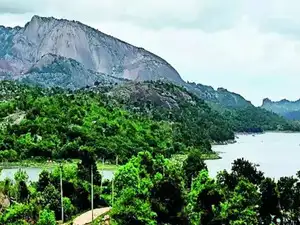 Agencies
AgenciesThe Cabinet also took note about the concerns expressed by certain sections of people regarding preparation of the Pre Feasibility Report of the SUMP, and the measures undertaken by the State Government for allaying fears and building consensus amongst likely Project Affected Families (PAFs) regarding this ‘National Project,’ through regular and detailed interactions with likely PAFs and various interactive meetings held at various levels by the State Government regarding the urgent need for preparation of the PFR for the SUMP.
The Cabinet re-emphasized the need for continuous engagement by the State Government with PAFs, and for the need to ensure fair, just and equitable compensation and solatium for all PAFs, in case construction of the SUMP was found feasible after successful conduct of the PFR.
The Cabinet directed the Department of Urban Development for the constitution of a New Yingkiong Development Authority and a New Geku Development Authority to enable building future-ready alternate towns. The Cabinet also directed that a committee be constituted under the chairmanship of the Secretary (Land Management) to examine land and property compensations rates, as well as to suggest the mechanisms to be adopted for designing and implementing a robust Rehabilitation and Resettlement Plan for PAFs.

The Cabinet also decided to request the Government of India to sanction a special development package for the Siang and Upper Siang Districts, including the beneficiary oriented social development for the twin districts.The Cabinet further directed the Public Works Department to initiate a survey for a necklace road along the Siang River above the likely submergence area on both banks of River Siang.Tsangpo River is known as Siang in Arunachal Pradesh and Brahmaputra in Assam and Jamuna in Bangladesh, and it flows through the neighbouring country (Bangladesh) before joining the Bay of Bengal.
Recently, the Arunachal Pradesh government expressed concern regarding China’s massive $137-billion hydroelectric dam project, which is set to produce 60,000 MW of electricity over the Yarlung Tsangpo River, in the upper reaches of Siang River in China.
Arunachal Pradesh Deputy Chief Minister, Chowna Mein had said that the Government of India has proposed the Upper Siang Multipurpose Project, a dam on the Siang River, which has the potential to generate up to 11,000 MW of electricity.
While sharing some observations made by experts on the environmental impact in the region of such a massive hydropower project over Tsangpo river, the Deputy Chief Minister said that if the China builds the dam over Yarlung Tsangpo river and diverts its water, it will dry up the Siang river and its distributaries affecting the aquatic life of the river and the large population in the plains of Assam and Bangladesh which depends on Brahmaputra river for the irrigation of their agricultural fields.
On the other hand, if any conflict arises between the two nations in future, it may release a large volume of water from the dam, which would cause unpredicted flooding in the downstream areas in Arunachal Pradesh and Assam causing loss of lives and properties.
He said that the implications of such a massive project over the Tsangpo river by the Chinese government cannot be ignored and asserted that in both the cases, the downstream people will be affected adversely. Considering all these factors, the Government of India has proposed the Upper Siang Multipurpose Project, a dam on the Siang River. The project is a crucial initiative aimed at mitigating the impacts of downstream flooding in Arunachal Pradesh, Assam, and Bangladesh and other environmental issues. The objective of the project is safety and security of the downstream people and to address other environmental issues, he said.
He said that the power generation is secondary and would be a byproduct of the project. He added that during the lean period, the project will act as a storage for the rainwater that falls in the Indian territory preventing the river water in Siang from drying up and in case of the release of large volume of water by China, the dam in the Siang river will act as a deterrent and release the water in a controlled way thereby moderating flood in the downstream.
Arunachal Pradesh has declared the years 2025-35 as the Decade of Hydro Power, in an effort to harness its significant hydropower potential estimated as 58,000 MW. During the Decade of Hydro Power, the Government aims to undertake strategic policy and governance measures not just to harness the hydropower potential through a judicious mix of mega, large and small hydroelectric projects, but also to create a stable and supportive policy and regulatory framework for the overall development of the industrial ecosystem in the State, both as a source of economic growth and as a means of generating employment and self-employment opportunities for youth of Arunachal Pradesh.
With around 19 GW of hydropower projects under development with cumulative investments of over Rs. 2 lakh crores in the next 10 years, Arunachal Pradesh is estimated to receive annual revenues of Rs. 4,525 Cr. from the sale of free power from HEPs from 2035 onwards. The Cabinet approved the creation of an escrow account for strategic management and effective utilization of the revenue generated from the proceeds of free power from HEPs. By effective management of these benefits, the state can make strategic and financial decisions about investing in overall development of the state. This initiative will not only streamline financial processes but also ensure that the benefits of Free Power are maximized for the state's long-term sustainable growth and prosperity, ultimately contributing to the realization of its strategic energy goals and the well-being of its citizens.











